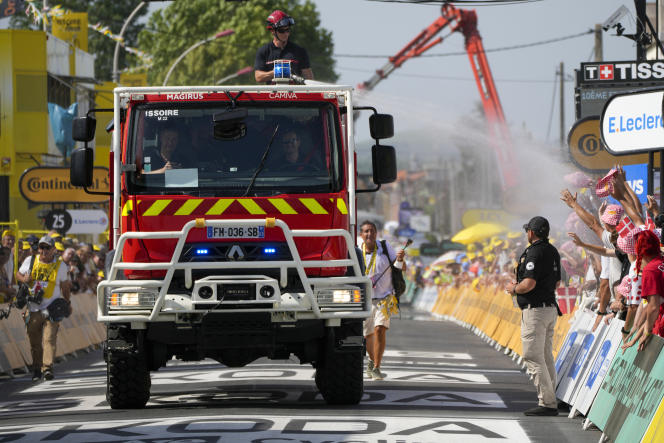Every morning, the sports directors of the twenty-two teams involved in the Tour de France scrutinize the profile of the route, the state of form of the troops and the weather. Tuesday July 11, at the dawn of the 10e stage between Vulcania and Issoire, won by Pello Bilbao (Bahrain-Victorious), it did not escape them that the Puy-de-Dôme department was on heat wave yellow vigilance, according to Météo-France.
“When we descended towards the finish, we really felt the heat waves”, says Matis Louvel, at the foot of the Arkéa-Samsic coach. On the line, shortly after 5 p.m., the mercury read 38 degrees Celsius (°C) with a feeling of around 42°C. Worthy of a rotisserie. As soon as they got off their bikes, the riders got into their bus, staggering and their faces marked with fatigue. “We expected it to be hot. We’ve had the information for two days, so we prepared the organizations.”explains Samuel Maraffi, doctor for the TotalEnergies training.
Because providing intense physical activity in hot weather is obviously not without danger to health. “There are two major risksadds Jacky Maillot, his counterpart in Groupama-FDJ. Dehydration, possibly with faintness and fainting, or exertional hyperthermia, when the body’s core temperature rises too much, which can cause loss of alertness. » Scientific knowledge being more and more precise, the teams are “more worried [des conséquences en termes de] performance than [d’un point de vue] medical “explains Samuel Maraffi.
“I got a little hot”, admitted David Gaudu (Groupama-FDJ), in great difficulty at the start of the day. Just like Romain Bardet, who “overheated”, told AFP his sports director at DSM-Firmenich, Matthew Winston. The heat released by the muscle, combined with the outside temperature, can explain this type of failure.
Twice as many water cans
To guard against this phenomenon, the teams organize themselves upstream to prepare the bodies. Three techniques – not recommended for amateurs – are used in the preparation: training in a naturally hot environment, in a room artificially heated to a desired temperature or passive acclimatization through sauna sessions. “When it’s hot before summer, I try to ride at lunchtime to get my body used to the heat”continues Matis Louvel.
During the stage, we saw a fire truck spraying water on the public and the Luxembourger Kevin Geniets doing the same with his teammates, one by one. Others slid ice cubes down their necks. “By doing this, we lower the body temperature by 0.4°C for about twenty minutes. It is very pleasant for the runners”specifies Jacky Maillot, who adds that he must “ensure rehydration strategies”. At best, by drinking regularly during the stage, the athlete will only be able to compensate for 50% of his losses for the day. “When you’re dehydrated, you can’t regain perfect hydration overnight.warns Jacky Maillot. It takes two or three days to recover, it generates a lot of fatigue. »
You have 45.42% of this article left to read. The following is for subscribers only.
